Sebastian Vivian, "Cascade"
Okay, maybe you’ll skitter.

This one is terrific. It swoops, loops, skitters and soars — all the things that you are probably not going to do today. It does, however, end abruptly, so perhaps you’ll have that in common. In any event, enjoy.
New York City, March 21, 2017

★★★★ The cold gray morning at dropoff was still gray but no longer cold an hour later. Another hour or less, and reflected sun was adding new spots to spotted brickwork while the clouds at the zenith thinned toward blue. The afternoon sun was full and dazzling. A boy with a backpack leaped from the back of a taxi to the top of an ice bank and teetered there, trying to get his center of gravity to the vertical, then gave up and leaped in reverse before he could slip into the waiting puddle below.
Remember Soundgarden?
Soundscan Surprises, Week of 3/16
Back-catalog sales numbers of note from Nielsen SoundScan.

The definition of “back catalog” is: “at least 18 months old, have fallen below №100 on the Billboard 200 and do not have an active single on our radio.”
Guardians of the Galaxy 2 is coming out on May 5, so sales of the first soundtrack, which are reliably and consistently high, brought the album to #1 last week. Elliott Smith’s Either/Or is twenty years old. Soundgarden’s full-length debut, Ultramega OK was re-released and remixed. Not sure why The Rolling Stones’ Hot Rocks saw a jump last week but perhaps you have some idea or news link you can share with me in the comments? All I could figure was that their debut greatest hits album was just over 45 years old, which doesn’t seem like a milestone but with these rock ’n’ roll guys you just never know.
I forgot who Halsey was and then Googled and then promptly forgot. She recently tweeted some secrets about her forthcoming album, which I guess made more people buy her old one. The habits of back catalog record-buyers will never cease to amaze me.
According to cduniverse.com, the Barchet Quartet was:
a remarkable German ensemble, the Barchet Quartet of Stuttgart, which emerged just after the Second World War. Because of the time and place in which it worked, it- did not achieve the fame of its contemporaries, the Smetana Quartet of Prague, the Amadeus Quartet of London, the Juilliard Quartet of New York, the Borodin Quartet of Moscow and the Quartetto Italiano of Milan.
They remain stubbornly not very Googleable when it comes to news stories, but perhaps your dad or mine could help us out in figuring out what led to this 147% jump in sales. Finally, I refused to tell you why Snoop Dogg’s (ahem, back then, Snoop DOGGY Dogg) Doggystyle is charting because the news moves so fast I’ve mercifully forgotten and I’d like to keep it that way.
1. SOUNDTRACK GUARDIANS OF THE GALAXY: AWESO 6,657 copies
4. SMITH*ELLIOTT EITHER/OR 4,159 copies
13. ROLLING STONES HOT ROCKS 1964–71 3,007 copies
20. SOUNDGARDEN ULTRAMEGA OK 2,623 copies
62. HALSEY BADLANDS 1,630 copies
194. BARCHET QUARTET; EMIL KESSINGE MOZART: COMPLETE STRING QUARTE 898 copies
200. SNOOP DOGGY DOGG DOGGYSTYLE 881 copies
(Previously.)
'Pete 'n' Tillie' (1972)
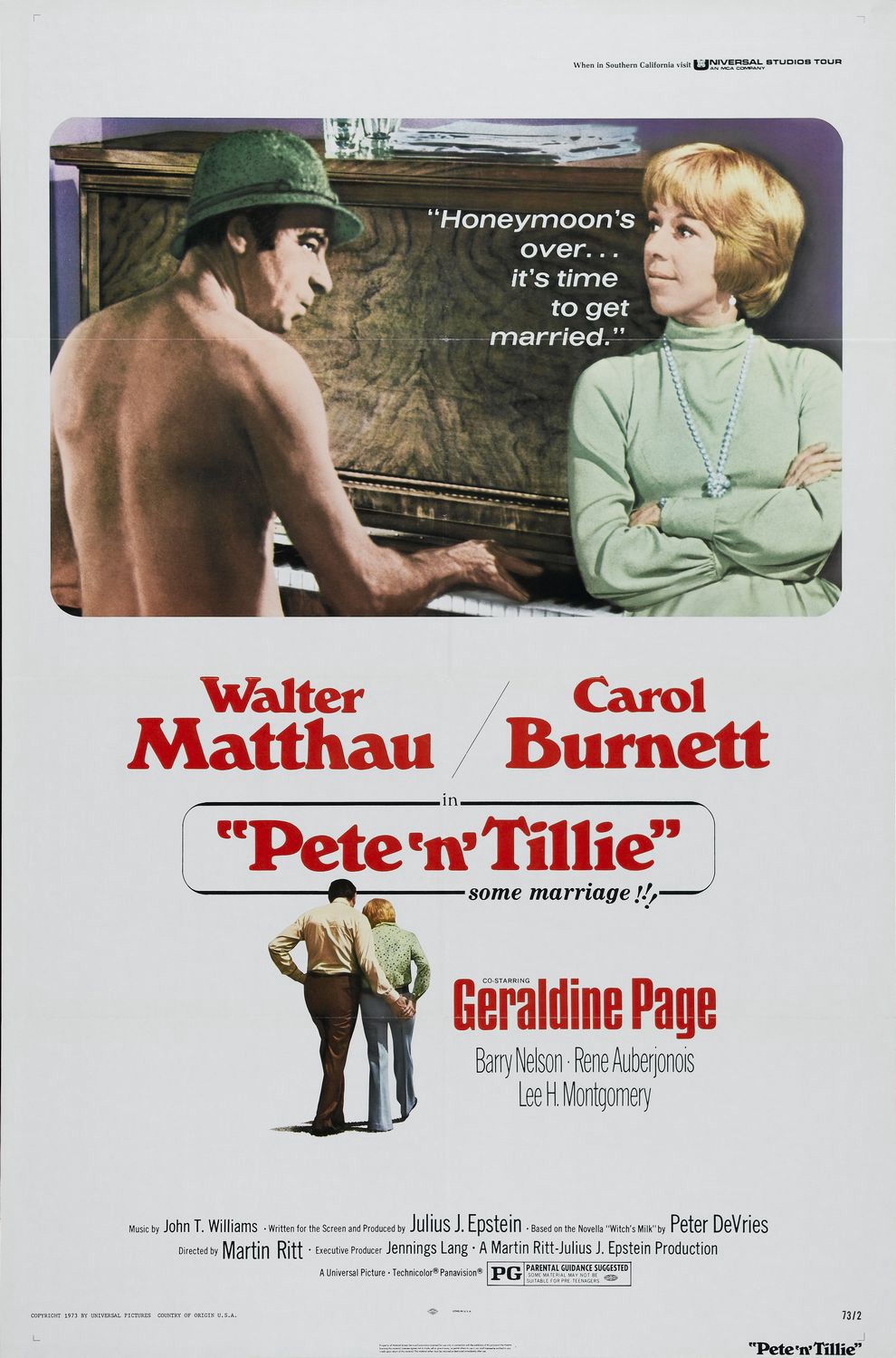
No one alive has a higher tolerance for Doris Day movies than I do, but I detested 1958’s The Tunnel of Love. In it, Richard Widmark — normally commanding and vigorous but, here, twitchy and miscast — contemplates cheating on his wife, played by Doris Day. Did you hear me? I said Doris Day.
The Tunnel of Love was based on the Broadway hit mined from a 1954 novel by Peter De Vries. In his 2004 New Yorker profile of De Vries, Jeffrey Frank laments that the author’s novels are now out of print and largely forgotten. It’s fair to wonder why, as the work of De Vries — who died in 1993 — earned enough acclaim during his lifetime to launch four Hollywood movies. All four films center on men of sketchy desirability who are either reliably bedded by attractive women or consider being unfaithful to what seem to be cracking good wives.
I have nothing nice to say about three of those movies: besides the smarmy The Tunnel of Love, there’s 1983’s smarmier Reuben, Reuben and 1970’s smarmy-sounding How Do I Love Thee? (it’s not on DVD or currently streamable so I haven’t seen it). But the fourth film, 1972’s Pete ’n’ Tillie, based on De Vries’s 1968 novella Witch’s Milk and directed by Martin Ritt, gets something exactly right about an enduring marriage’s disappointments: they are persistent but neutralized by time.
The schlubby Pete (Walter Matthau) and the tamped-down Tillie (Carol Burnett, brilliantly cast against type) meet at a party at the Bay Area home of Tillie’s matchmaking best friend, Gertrude, who is on the knifepoint between studied good grace and natural-born vulgarity as only Geraldine Page could have played it. Tillie is a secretary; Pete is in “motivational research,” which means that he’s all about the sell and always has a line ready. In front of Gertrude’s guests, who include her priest, Pete tells her, “I didn’t know you were asking Father Keating. I demand equal time for my rabbi.” When Gertrude asks why he identifies as a Jew when he’s three-quarters Lutheran, Pete says, “Because I’m a social climber.”
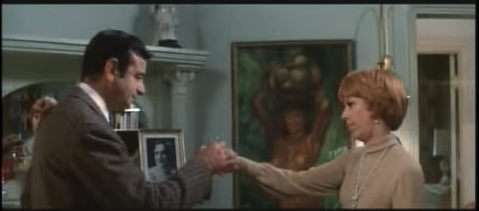
Tillie, a teetotaler, doesn’t laugh at his jokes. To his not at all impertinent question “Where were you born?” Tillie answers “Why?” Pete admires both her resolve and her quick wit: “You have possibilities,” he tells her after she makes a decent pun. With her perpetually crossed arms (on which Pete remarks), Tillie has the bearing of someone who has been wounded, although there’s no backstory here beyond a reference to a father who bailed early. Presumably being a thirty-three-year-old single woman in the 1970s is sufficient reason to live life on the defensive.
It’s only after they start sleeping together that Tillie feels she can smile around Pete, whose entertainment value, as when he plays his piano starkers, she can’t deny. But after one of their trysts, she finds a woman’s hairpins on his bedroom floor. She shows them to him. They both pretend the pins belong to his cleaning lady.
The characters’ rat-a-tat exchanges are faultless; Burnett and Matthau, here in their first screen collaboration, are like a low-energy version of Pete’s beloved Abbott and Costello. But after they’ve been dating awhile, it’s Tillie who has the best line: “The honeymoon’s over. It’s time to get married.” Tillie and Pete move to the suburbs, where she uncrosses her arms to embrace full-time motherhood.
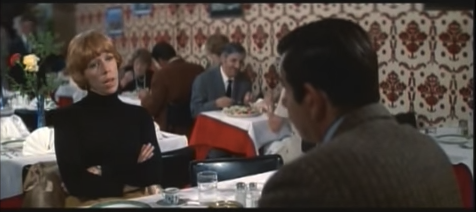
The honeymoon is really over the day Tillie goes to Pete’s office to surprise him. A receptionist tells her that he’s not on the premises, so Tillie waits. Eventually she spots Pete in a hallway talking to an attractive younger woman whose hair he fiddles with. For a fleeting, uncharacteristic moment, Tillie becomes a Carol Burnett character: she hides in the office john. That night she confronts Pete; he says the woman is a new employee and scrambles for a joke. This won’t be Pete’s only other woman. If Tillie considers leaving him, one impediment is the effect that this would have on their son. As the movie makes carousingly clear, Pete is the all-laughs dad that one would expect Walter Matthau to be.
I don’t know if there’s another comedy-drama that better accommodates the sort of horror that life occasionally drops anvil-like on the least suspecting and even less deserving. Following just such a tragedy, Tillie and Pete retreat to separate corners of their marriage. One night, Pete, sozzled, points out that they haven’t had sex in a year. Tillie has no objection when he tells her that he will once again be working late, so to speak, the following evening. He takes an apartment in town.

Adrift, Tillie throws herself into charity work with Gertrude. At lunch one afternoon, she tells the elegantly oily Jimmy Twitchell (René Auberjonois), a gay friend in Tillie and Gertrude’s circle, that she is going to the police station the following day to formally register a lottery that the charity is holding. Jimmy insists that Tillie take Gertrude with her because the police will, as a matter of course, ask Gertrude her name, address, and age, the last of which he has long been desperate to learn. “I can’t do that to my best friend,” Tillie says. “But darling,” Jimmy says, “what are best friends for?”
At the station, Gertrude responds to the question of her age with a succession of nonsense syllables and then makes a quick getaway: a dead faint, probably faked. Once they’re outside, Gertrude tells Tillie, “You did this deliberately. You planned it!” She swings her pocketbook like a cudgel; Tillie, who has much more to be mad about, swings hers harder. She threads a running garden hose up Gertrude’s dress; Gertrude puts a trash barrel over Tillie. This sounds like comic relief — the clowning promised by Burnett’s name on the movie theater marquee — but the scene is shot with a marvelous, almost wordless brutality. In another movie, their blows would have concluded with spluttering laughter. Here, once Tillie has pulled off Gertrude’s wig, the scene, and for all we know the friendship, ends. So much for the narrative cliché that catharsis breeds clarity: Tillie goes from the catfight to a mental health facility. But she hasn’t seen the last of Pete.

Pete ’n’ Tillie was well received at the time of its release, earning deserved Oscar nominations for supporting actress Page and screenwriter Julius J. Epstein, but I’m aware of the film only because Burnett mentions it in her 2010 memoir, This Time Together. Part of what may have hurt Pete ’n’ Tillie’s chances at enduring recognition is that it’s about something that not even Pete could market easily: two middle-aged lovers who don’t look like movie stars.
It’s also possible that the film disappeared for the same reason that I suspect De Vries’s work did: having heard the gong of the women’s movement and other cultural wake-up calls, the public may have lost at least some of its taste for, or maybe patience with, stories about the middle-aged American male’s sense of sexual entitlement. At least I hope it did. There’s a clue that the filmmakers felt less indulgent of Pete than De Vries did: they invented a scene in which Gertrude’s husband propositions Tillie. (She turns him down.) Although Pete cheats on her, Tillie’s desirability is not in question.
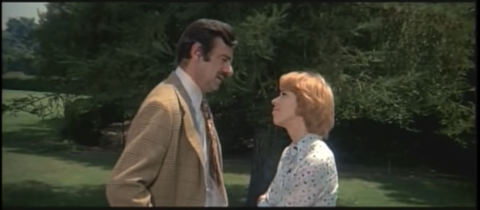
Pete ’n’ Tillie’s ending is both the right one and not the one you wanted. If the film had been made in Doris Day’s time, it would have concluded with dueling Technicolor apologies and a glossy smooch. If it had been made today, I can picture a one-way spray of expletives followed by an applause line and flag-planting in the land of female self-sufficiency. But Pete ’n’ Tillie came out between fifties romanticism and the socially aware idealism of right now. Splitting the difference between Pillow Talk and Thelma and Louise, Pete ’n’ Tillie plants its flag in 1970s realism’s heart. Tillie may not end up uncomplicatedly committed to her fate, like the protagonists in those two movies, but someone of her generation and type — probably not you, and surely not me — might consider herself no worse off than Doris Day, who, after all, got stuck with a dick like Richard Widmark now and then.
Nell Beram is coauthor of Yoko Ono: Collector of Skies and a former Atlantic Monthly staff editor. She writes occasional Best Forgotten columns for The Awl.
How Do You Sleep?
Here’s what my nights are like now.

BRAIN: Wake up, wake up!
ME: What? What is it? Fire? Is there a fire? Is someone breaking in?
BRAIN: No, I just wanted to hang out. I was lonely.
ME: It’s 3:17. In the morning.
BRAIN: The worst time to be alone.
ME: OR AWAKE.
BRAIN: Oh, when did you get so old? It used to be at 3:17 you’d be yelling, “The night is just getting started! Sleep is for the weak!”
ME: That was never true. If I remember correctly, the times I was out at 3:17 it was you who was all, “This is not going to end well.”
BRAIN: Oh, who even remembers? Anyway, we’re up now. Aren’t you worried about Trump?
ME: You know I can’t worry about anything else! It’s just a constant state of fear, every second! Even ignoring the uncertainty caused by his complete incompetence I’m horrified by what he’s enabling, or what the powers behind him are enabling. And Gorsuch? Oh my God, they are going to lock in this minority agenda for YEARS TO COME. It will take so much effort to undo these things that by the time they are finally fixed it will be too — wait a second.
BRAIN: No, go on, these are good points.
ME: You’re trying to keep me up! I’m EXHAUSTED, can we please go to sleep?
BRAIN: Remember the ‘80s? [Plays montage of ’80s news events and commercials, including the Snoopy Sno-Cone Machine jingle, Reagan saying “Tear down this wall,” and the “Diff’rent Strokes” episode where Dudley gets molested by the guy from “WKRP in Cincinnati.”]
ME: Stop that. Stop putting those things in my head all the time.
BRAIN: I’m so bored! And I’m not tired at all! I feel like we should just stay up until morning.
ME: You’re killing me. Please, please, please, I’ve been tossing and turning all night.
BRAIN: [Plays Bobby Lewis’ “Tossin’ and Turnin’”]
ME: Okay, that’s a little obvious even for you. Knock it off or I’m going to drown you in Ambien. I’m already a wreck during the day these days, you can’t take the nights away from me.
BRAIN: Fine. I’ll be quiet. Go to sleep. I’ll just adjust these neurotransmitters.
[Five minutes passes]
BRAIN: You think he’ll be impeached?
A Fine German Childhood Is Full of Death
Deutschland über us.

Last week at the White House, the leader of the free world held a long-anticipated meeting with Donald Trump. It went about as well as expected. And, after the President of the United States refused to shake German Chancellor Angela Merkel’s damn hand, the Germans reacted by making beautiful use of their freedom to reason freely, as Kant would say, by which I mean they created hella memes.
There’s this one:
Mutti schafft sie alle 😎 #Trump #Merkel
And this one:
Süße Erinnerungen #MerkelTrump
And the best one of all:
Ladies and Gentlemen, wir haben ein neues Meme #merkeltrump
Here, The top line says, “HAVE YOU CLEANED YOUR ROOM?” The bottom says: “LOOK AT ME WHEN I’M TALKING TO YOU.”
Hahaha get it? Because all of Germany sees Merkel as the mom and Trump as the petulant fourth-grader who (may or may not have) light-treasoned himself into the Oval Office.
And while American mothers also enjoy this exact exchange with their petulant fourth-graders, our cultural context is a bit different. For an American kid, the implied “or else” in the second line might mean, say, the loss of one’s backup iPad, or perhaps some mild corporal punishment. For a German kid, the “or else” means he’ll be set on fire in his sleep. This is because by the time a German kid has reached the petulant fourth-grader stage, he has been brined like a veritable Sauerbraten in a milieu of misbehavior-related violence and death.
I’m not just talking about the original versions of the Grimm Märchen, or fairytales, which are of course way grosser than the sanitized Disneyfied versions you know. Because the Märchen are to German children’s-story violence what Bluth-level treason is to Trump-level (alleged) Treason.
Allow me to introduce you to der Struwwelpeter (dair STROO-vul-PAY-tur), the 1845 book by Heinrich Hoffmann of “merry stories and funny pictures,” a.k.a. basically the German version of Mother Goose, but with way more death and dismemberment. This explains so, so much.
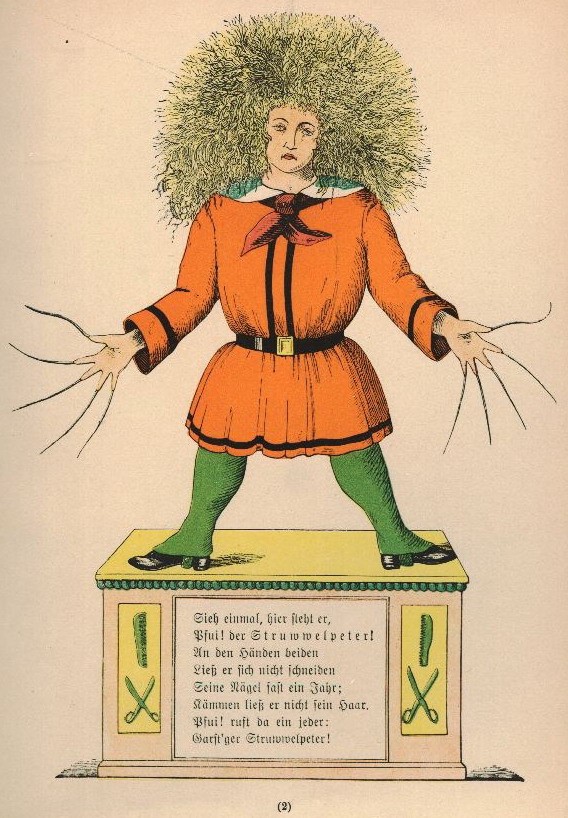
If, for example, you suck your thumb, like poor Konrad here, this Joker-looking dude will straight chop it off.

And ’member the kind but firm bear with the booming voice who told us not to play with matches? Meet the German equivalent, Paulinchen (pao-LEEN-shen), who ignores the warnings of her cats, and burns the fuck to the ground.
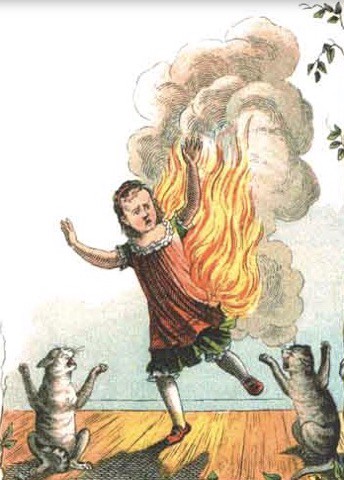
And then, for the picky well-done steak-and-ketchup eaters out there, here’s der Suppen-Kaspar (ZOOP-un-KOSS-parr), who won’t eat his goddamned soup, and so he ends up like this.
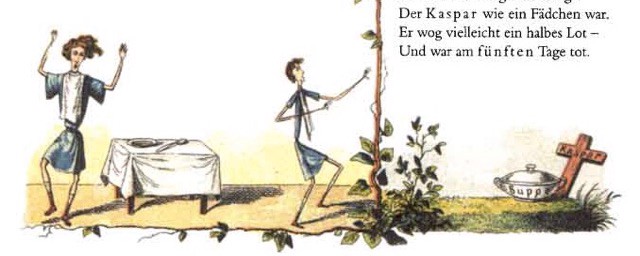
As a result, Germans grow up eating their damn soup (that’s a metaphor for “obeying authority”), and also with a somewhat less romanticized view of our inevitable shuffling off of the mortal coil.
Back when I was a German professor, I used to enjoy shoving my American college students right into the deep end of this particular icy Bavarian stream by showing them, on the first day of class, the 1912 poem “Schöne Jugend,” or “A Fine Childhood,” by Gottfried Benn, who worked by day in a Berlin morgue.
The mouth of a girl who had long lain in the reeds
looked so chewed on.
When we broke open her chest
the esophagus was so full of holes.
Finally, in a bower under the diaphragm
we found a nest of young rats.
A little sister lay dead.
The others lived off the liver and kidneys,
Drank the blood and had enjoyed here
a fine childhood.
And fine and fast came their death, too:
We threw them all together into the water.
Oh, how their little snouts squeaked!
(Translation: me!)
“How do you know she’s a prostitute?” I’m glad you asked, Astute College Freshman. You see, her prostitudinousness is implied, because she’d been ditched in the reeds for long enough that clearly nobody was looking for her, and also because the “fine childhood” she clearly did not get to have is contrasted with the disease-ridden vermin who inhabit her body cavities. Gottfried Benn rules, right? Wait, what is this “drop slip” you are placing in front of me?
Yes, I get it, this is probably a very shocking tableau for American youngsters, given that even amidst the gore of games both video and Throne, kids here still grow up hearing that all their pets are chilling at a farm “upstate,” and all their relatives have “passed on” to a “better place,” with not a rat or perforated internal organ in sight. Germans, for better and worse (and then much worse, and then much, much worse, and then slightly less worse, and then better again), do not have the same weird ingrained denial-slash-romanticization of death that we do.
And this means, obviously, that der Suppen-Drumpf is one motherfucker who’s fucked with the wrong mother.

Junk Foodie
The Adventures of Liana Finck
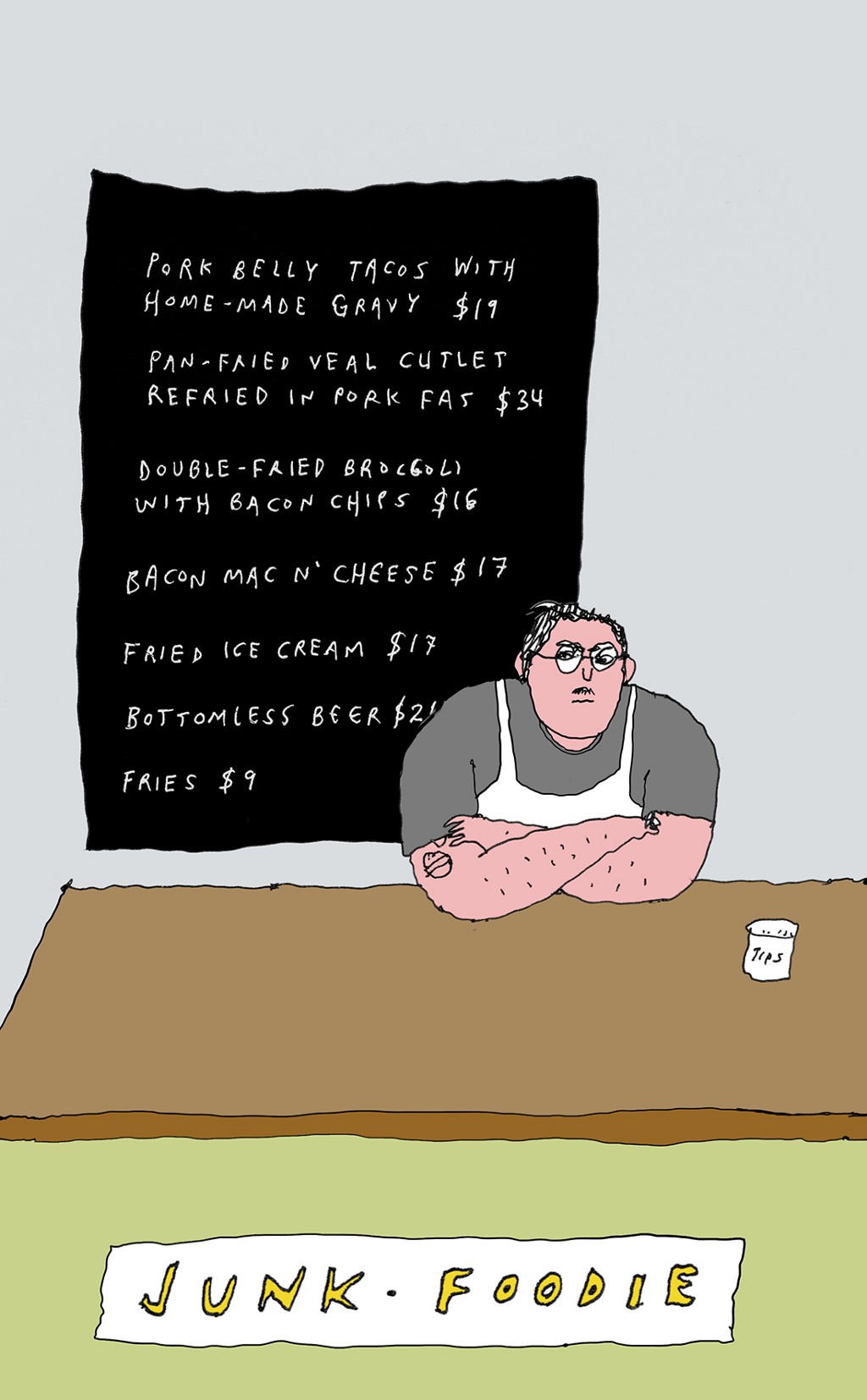
Liana Finck’s work appears in The New Yorker and Catapult, and on her Instagram feed.
Defled, "Cluster"
Nothing makes sense anymore and you can’t even walk around in it.

I still can’t help but wonder why things are the way they are: Why have we gone backwards when it seemed we’d come so far? How can one stay centered when the center cannot hold? But most of all, I’d like to know why it’s so fucking cold. Anyway, here’s this, enjoy it, bundle up today.
New York City, March 20, 2017

★★★ Pigeons banked against the bright sky. The winter chill at dropoff time quickly eased away. An orphan lump of snow, like a glacial erratic, sat near the middle of the sidewalk with a trail of meltwater leading away from it. Walking in a sweater with a parka slung over an arm was not as cold as wearing the parka was hot. Puddles filled the grooves left by tires in the curbside ice.
Dominos Has The Only Good Ads On Instagram
It’s like the Dove Real Beauty campaign but for pizza.

I have written before about my Instagram problem. It’s mostly under control, and it’s been helped by the fact that I have a LOT MORE ADS in my feed lately. Many of them are horrible and stupid and make me feel fat and like I don’t take enough vacations, but some of them look like my friends are posting pictures of their fresh Domino’s pizza deliveries. And that’s because the Instagram ads that Domino’s uses are just, not even “realistic” but “actual real photos of pizza,” probably re-touched but only in a way that enhances the photograph as a whole but doesn’t mess with the integrity of the product if you know what I’m saying? What I’m saying is: grease stains on cardboard. Too much flash. Bad lighting. Toppings that are out of focus. And you know what? I want every one of those pizzas. Solid and Striped ads be damned.
Last week Bloomberg published a feature on the resurrection of Domino’s and its propulsion to global sales of $10.6 billion. The piece largely focuses on the technological prowess of their little progress-bar app/interactive web thing that I know you’ve used, don’t lie, as well as other advances in delivery methods (drones, subcompact cars with warming ovens built in), but one paragraph in particular stood out to me:
Russell Weiner, who’d come from PepsiCo Inc. in 2008 to be Domino’s chief marketing officer and is now president of U.S. operations, picks up the story from there. Wiry from losing 50 pounds on the Pritikin diet, he talks fast and keeps a giant bowl of clementines in his office. Flush with success from their first honesty offensive, Weiner and his team started discussing fresh ways for Domino’s to ridicule itself. “We asked: ‘What else in our industry isn’t transparent?’ ” he says. One obvious answer: the photos used for menus and marketing. “During the shoots, they put extra melted cheese in the cracks after cutting the pizza and blow it dry,” he says. “We call it cheese porn.” The company’s next TV spot showed what really happens on a photo shoot, along with Domino’s promise, henceforth, to use only photos of pizza that its employees had actually made.
For one thing, I love a skinny fast-food executive. For another, Domino’s isn’t going to tell you life is prettier than it is. You might be ashamed that you want some cheesy bread with your pepperoni-and-nothing-else delivery pizza, but Domino’s isn’t, and it wants you to know that. Domino’s is here for your basest habits, to nurture and celebrate them. You want greasy, straight-up regular-ass pizza that makes your apartment smell like old cheese and dried red sauce and you want it fast. It’s kind of a nice change from the avocado-topped vegan grain bowls your coworker keeps posting, isn’t it?
